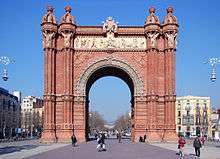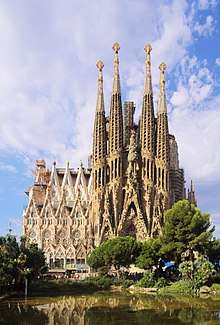Neo-Mudéjar
The Neo-Mudéjar is a type of Moorish Revival architecture practiced in the Iberian Peninsula, and a far lesser extent Ibero-America. This architectural movement emerged as a revival of the Mudéjar style. It appeared in the late 19th century in Madrid, and soon spread to other regions of the country. Such architects as Emilio Rodríguez Ayuso perceived the Mudéjar art as characteristical and exclusive Spanish style. They started to construct buildings using some of the features of the ancient style, as horseshoe arches, arabesque tiling, and the use of the abstract shaped brick ornamentations for the façades.[1]
History
_10.jpg)
The first examples of Neo-Mudéjar style were the bullring constructed in 1874 on Plaza de Toros in Madrid (now demolished), the Aguirre School designed by Rodríguez Ayuso,[1] and Casa Vicens by Gaudí.[2] The style became then a strong, almost "compulsory" reference for the construction of bullfight rings all around Spain and beyond the borders, to Portugal and the Hispanoamerican countries. In Madrid it became one of its most representative styles, not only for public buildings, like Aguirre School or the bullring of Las Ventas, but also for housing. The use of cheap materials, mainly brick for exteriors, made it a popular style in the new neighborhoods.
Neo-Mudéjar was often combined with Neo-Gothic by architects such as Francisco de Cubas, Antonio María Repullés y Vargas or Francisco Jareño. After the Ibero-American Exposition of 1929 in Seville, another stream of Neo-Mudéjar features appeared: the Andalusian Architectural Regionalism. The Plaza de España (Seville)[3] or the ABC newspaper headquarters (Madrid) are examples of this new style that combined traditional Andalusian architecture with Mudéjar features.
List of notable Neo-Mudéjar buildings
- Arenas de Barcelona
- Gran Teatro Falla, Cádiz
- Las Ventas bullring, Madrid
- Church of Santa Cruz, Madrid
- Church of La Paloma, Madrid
- Water tower (now exhibition space) Torre de Canal Isabel II, in Madrid.
- Escuelas Aguirre, Madrid
- Toledo railway station
- Zaragoza Post-Office
- Campo Pequeno bullring in Lisbon, Portugal, inspired in Madrid Bullring by Rodríguez Ayuso.
- Morisco Kiosk, Mexico City
- Palacio de Orleans-Borbón[4]
Gallery
_Palacio_Laredo%2C_entrada_principal.jpg) Palacio Laredo in Alcalá de Henares, 1884
Palacio Laredo in Alcalá de Henares, 1884_04.jpg) Las Ventas bullring, Madrid, 1929
Las Ventas bullring, Madrid, 1929 Mudéjar Pavilion, Museum of Arts and Traditions, Seville, 1914
Mudéjar Pavilion, Museum of Arts and Traditions, Seville, 1914 Arc de Triomf, Barcelona, 1888
Arc de Triomf, Barcelona, 1888.jpg) Campo Pequeno bullring in Lisbon (Portugal), 1892
Campo Pequeno bullring in Lisbon (Portugal), 1892.jpg)
 Neo-Mudéjar building in Seville, 1909
Neo-Mudéjar building in Seville, 1909.jpg) Church of Niño Jesús in Madrid, by Francisco Jareño, 1885
Church of Niño Jesús in Madrid, by Francisco Jareño, 1885.jpg) Casa del Reloj, Arganzuela, Madrid, 1933
Casa del Reloj, Arganzuela, Madrid, 1933- Gran Teatro Falla of Cádiz, 1884
_01.jpg) Comillas Pontifical University building in Madrid
Comillas Pontifical University building in Madrid_Ermita_de_la_Virgen_del_Val%2C_fachada_principal.png) Ermita de la Virgen del Val in Alcalá de Henares, 1926
Ermita de la Virgen del Val in Alcalá de Henares, 1926
References
- Editors of Time Out (13 December 2013). Time Out Madrid. Time Out. p. 21. ISBN 978-1-84670-297-6.CS1 maint: extra text: authors list (link)
- Alejandro Lapunzina (1 January 2005). Architecture of Spain. Greenwood Publishing Group. p. 56. ISBN 978-0-313-31963-1.
- Jeremy Head (31 January 2011). Frommer's Seville, Granada and the Best of Andalusia. John Wiley & Sons. p. 1230. ISBN 978-1-119-99445-9.
- AnneLise Sorensen; Geoff Garvey (30 March 2009). The Rough Guide to Spain. Penguin. p. 588. ISBN 978-1-84836-838-5.
External links
- ARQUITECTURA DEL SIGLO XIX by Inmaculada Rodríguez Cunill. (ISBN 84-9714-009-5)

